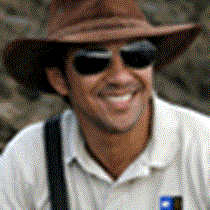Santa Cruz Island
The center part of the Galápagos archipelago is formed by a bunch of middle age islands; one of them is called Santa Cruz, and it happens to be the center of tourism activities in the Galápagos. Our morning started by visiting one of the most famous research centers in the world, the Charles Darwin Research Station (CDRS).
This facility was our first exposure to the reptiles that have become, over time, the emblematic species in the Galápagos, the famous Galápagos Giant Tortoises. We not only got to see tortoises, but we learned about the several programs developed well over 30 years ago to protect all the species that form the intricate ecosystem of the islands.
It was also here where Lonesome George was seen and photographed, as he willingly exposed himself around his private pool! Large tortoises weighing as much as five hundred pounds were also observed in the several corrals that the station has created to keep some of these reptiles; although in captivity, these tortoises have a much better life than what they used to have when they were found in circuses, zoos and people’s houses some twenty years ago.
As we all wanted to see them in their natural habitats, we rode a bus to the highlands to encounter a completely different ecosystem than we have seen so far. The lush and green highlands is the habitat for many different species, mostly land birds such as several species of finches, owls, flight catchers, doves, mockingbirds, just to mention a few. It is also here where giant tortoises have found the perfect territory, creating “tortoises highways” that we were following to find them way deep into the forest.
As our third day in the Galápagos is coming to an end, we realize that we have seen so much already, but we are also sure that many more exiting adventures are waiting for us tomorrow…
The center part of the Galápagos archipelago is formed by a bunch of middle age islands; one of them is called Santa Cruz, and it happens to be the center of tourism activities in the Galápagos. Our morning started by visiting one of the most famous research centers in the world, the Charles Darwin Research Station (CDRS).
This facility was our first exposure to the reptiles that have become, over time, the emblematic species in the Galápagos, the famous Galápagos Giant Tortoises. We not only got to see tortoises, but we learned about the several programs developed well over 30 years ago to protect all the species that form the intricate ecosystem of the islands.
It was also here where Lonesome George was seen and photographed, as he willingly exposed himself around his private pool! Large tortoises weighing as much as five hundred pounds were also observed in the several corrals that the station has created to keep some of these reptiles; although in captivity, these tortoises have a much better life than what they used to have when they were found in circuses, zoos and people’s houses some twenty years ago.
As we all wanted to see them in their natural habitats, we rode a bus to the highlands to encounter a completely different ecosystem than we have seen so far. The lush and green highlands is the habitat for many different species, mostly land birds such as several species of finches, owls, flight catchers, doves, mockingbirds, just to mention a few. It is also here where giant tortoises have found the perfect territory, creating “tortoises highways” that we were following to find them way deep into the forest.
As our third day in the Galápagos is coming to an end, we realize that we have seen so much already, but we are also sure that many more exiting adventures are waiting for us tomorrow…




